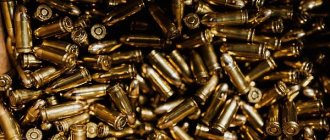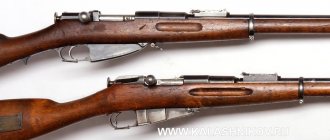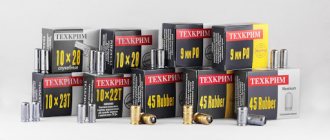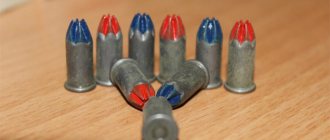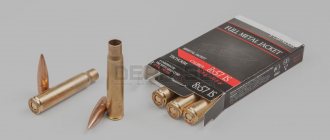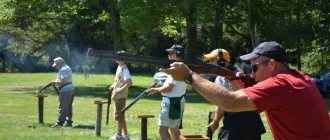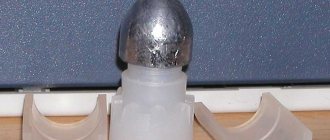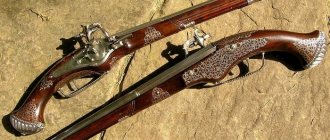Descriptions and markings of 7.92x57 Mauser cartridges
Reference materials From the mid-1930s until the end of the war in 1945. on cartridges produced in Germany, the countries it occupied and produced for Germany in other countries, markings with a non-segmented arrangement of marks were usually used: with four elements, rarely with two elements. The marking included a manufacturer's code intended to encrypt the plant. Until 1940, with few exceptions, this code consisted of the letter "P", often followed by two or three digits. Since 1941 this code was often replaced by an alphabetic code consisting of one, two or three letters. The markings on the bottom of the cartridge case use a 12 o'clock dial (like a watch) to make the marks easier to read. In the standard four-element marking, the manufacturer is located at 12 o'clock. The 3 o'clock code indicates the case material; “St” or “St+” indicate that the sleeve is steel, varnished or copper-plated. The combination of Roman numerals (from I to XXII) corresponds to the steel mill that supplied the shell metal; a capital letter indicates the plant that carried out the process of varnishing the shell, etc. Arabic numbers (1,2,3,6,15 or 17) indicate the grade of steel of the copper or brass coated sleeve (example: P181 Xw1 49 38). The marks “*” or “S*” indicate that the case is made entirely of brass. If there is a “\” between the manufacturer code and the case material code, then the case has only one primer hole at the primer. The batch number is indicated at 6 o'clock; the year of manufacture code, consisting of the last two digits, is located at 9 o'clock. (1937 - 1941) Code with letter "P"P14
| ? | |
| P25 | ? |
| P28 | DeutscheWaffen-u. Munitionsfabrik AG, Werk Karlsruhe. G. Durlach |
| P34 | ? |
| P67 | H. Uttenörffer, Munitionsfabrik, Nuremberg |
| P69 | Sellier & Bellot, |
| P94 | Kabel-u. Metallwarenfabrik Neumeyer AG, Nuremberg |
| P120 | Dynamit AG, Werk Hannover-Empelde, |
| P128 | ? |
| P131 | DWMAG, Werk Berlin-Borsigwalde, Berlin |
| P132 | ? |
| P150 | ? |
| P151 | Rheinische-Westfälische Sprengstoff AG, Nuremberg |
| P152 | ? |
| P153 | ? |
| P154 | Polte Werke, Grünberg |
| P160 | ? |
| P162 | ? |
| P163 | ? |
| P181 | Hasag, Hugo Schneider AG, |
| P186 | ? |
| P198 | Metallwarenfabrik Treuenbritzen GmbH, Werk Belsig, Mark, |
| P207 | Metallwerke Odertal GmbH, Odertal |
| P224 | ? |
| P249 | Finower Industriewerk GmbH, Finow/Mark, |
| P265 | ? |
| P270 | ? |
| P315 | Märkisches Walzwerk GmbH, Strausberg |
| P316 | Westfälische Metallindustrie, Lippstadt, Westfalen, |
| P327 | ? |
| P334 | Mansfeld AG, Rothenburg an der Saale, Rothenburg |
| P340 | Metalwarenfabrik Silberhütte, St. Andreasberg, St. Andreasberg |
| P345 | ? |
| P346 | H. Huck, Metallwarenfabrik, Nürnberg W, Nuremberg |
| P369 | ? |
| P370 | ? |
| P379 | Scharfenberg-u.Teubert GmbH, Breitungen |
| P382 | ? |
| P397 | ? |
| P398 | ? |
| P405 | Dynamit AG, Durlach |
| P413 | ? |
| P414 | ? |
| P417 | ? |
| P442 | ? |
| P457 | ? |
| P490 | ? |
| P491 | ? |
| P635 | Munitionsfabrik Wöllersdorf, Wien |
| P757 | ? |
Manufacturer codes
| a | Aug.d.Haer, Metallwerke, Troisdorf, Troisdorf |
| b | Sundwiger Messingwerke, Sundwig Kreis Iserlohn |
| c | Vereinigte Deutsche Nickelwerke AG, Schwerte (Ruhr), Ruhr |
| d | Vereinigte Deutsche Nickelwerke AG, Werk Laband |
| e | Trierer Walzwerk AG, Werk Burg bezirk Magdeburg, Magdeburg |
| f | Mansfeld AG, für Bergbau und Hüttenbetrieb, Finow (Mark), |
| g | Hirsch Kupfer u. Messingwerke AG, Zentrale Berlin, Berlin |
| h | Wielandwerke AG, Metallhalbfabrikate, Ulm (Donau) |
| j | R.und G. Schmöle Metallwerke, Menden (Westfalen), |
| l | Dürener Metallwerke AG, Werk Metallhalbfabrikate Düren, Düren (Rheinland) |
| m | FA Lange Neusilberfabrikate AG, Aue (Sachsen) |
| n | Westfälische Kupfer-u. Messingwerke AG, vorm. Caspar Noell, Lüdenscheid (Westfalen) |
| o | Eduard Hueck Metallwarenfabrik, Lüdenscheid (Westfalen) |
| p | Stollberger Metallwerke KG (von Asten, Lynen-u. Schleicher), Stolberg (Rheinland) |
| q | Wilhelm Prym Metallfabrikate, Stollberg (Rheinland) |
| r | Deutsche Messingwerke Carl Eveking AG, Metallhalbfabrikate, Berlin-Niederschönnwalde, Berlin |
| s | Dynamit AG, vorm. Alfred Nobel-u. Co. Werk Skt Lambrecht |
| t | Dürener Metallwerke AG, Berlin-Borsigwalde, Berlin |
| u | Osnabrücker Kupfer- u. Drahtwerke AG, Osnabrück |
| v | Kabel-u. Metallwerke Neumeyer AG, Nuremberg |
| w | Hugo Schneider AG Messingwerke, Taucha-Leipzig, |
| x | Busch-u. Jäger Lüdenscheider Metallwerke AG, Lüdenscheid |
| y | Sächsiche Metallwarenfabrik Aug.Wellner u. Sohn AG, Aue, (Sachsen) |
| z | Kupferwerk Ilsenburg AG, Ilsenburg (Harz) |
| ac | Vereinigte Deutsche Nickelwerke AG, Schwerte (Ruhr), Ruhr |
| ba | Sundwiger Messingwerke, Sundwig Kreis Iserlohn |
| bb | A. Laue und Co, Berlin Reinickendorf, Berlin |
| bc | Kupfer-u. Messingwerke AG, Becker-u. Co., Langenberg (Rheinland) |
| bd | FA Lange Metallwerk AG, Bodenbach (Sudeten) |
| be | Berndorfer Metallwarenfabrik Arthur Krupp, Berndorf (Niederdonau) |
| dm | Deutshe Waffen und Minitionsfabriken, Karlsruhe |
| ca | Vereinigte Deutsche Nickelwerke AG, Schwerte (Ruhr) (1941), Ruhr |
| eh | Trierer Walzwerke AG, Werk Burg bezirk Magdeburg, Magdeburg |
| fa | Mansfeld AG für Bergbau und Hüttenbetrieb, Hettstedt (Harz) |
| ga | Hirsch Kupfer-u. Messingwerke AG, Finow (Mark), |
| ma | FA Lange Neusilberfabrikate AG, Aue (Sachsen) |
| mw | Munitionswerke, Shoenebeck |
| na | Westfälische Kupfer-u. Messingwerke AG, vorm. Caspar Noell, Lüdenscheid (Westfalen) |
| pm | Polte Armaturen und Mashinenfabrik AG, Magdeburg |
| un | Utendoerffer, H, Nuremberg |
| ra | Deutsche Messingwerke Carl Eveking AG Metallhalbfabrikate, Berlin-Niederschönwalde., Berlin |
(1941 — 1945) Manufacturer codes
| ad | Patronen-, Zündhütchen-u. Metallwarenfabrik AG, Schönebeck an der Elbe |
| ak | Munitionsfabriken vormals Sellier und Bellot, Werk Vlasim, Prag |
| am | Gustloff Werke, Otto Eberhardt Patronenfabrik, Hirtenberg, Niederdonau |
| asb | Deutsche Waffen-u. Munitionsfabriken AG (DWM), Berlin-Borsigwalde, Eichborndamm |
| aux | Polte-Werke, Werk Magdeburg |
| auy | Polte-Werke, Werk Grüneberg |
| avu | Silva Metallwerke GmbH, Werk Genthin |
| bne | Metallwerke Odertal GmbH, Odertal Post Lautaberg/Harz |
| cg | Finower Industrie GmbH, Finow/Mark |
| ch | Fabrique Nationale d'armes de guerre SA, Herstal/Liège, Belgique |
| dnf | Rheinisch-Westfälische Sprengstoff AG, Werk Stadeln bei Nürnberg |
| dom | Westfälische Metall-Industrie AG, Lippstadt, Westfalen |
| dot | Waffenwerke Brünn AG, Werk Brünn |
| dou | Waffenwerke Brünn AG, Werk Povaszka Bystrica |
| eba | Scharfenberg & Teubert GmbH, Metallwarenfabrik, Breitungen-Werra |
| edq | Deutsche Waffen-u. Munitionsfabriken AG, Lübeck-Schlutup |
| eej | Markisches Walzwerk GmbH, Straussberg Bezirk Potsdam |
| eey | Metallwarenfabrik Treuenbritzen GmbH, Werk Roederhof |
| emp | Dynamit AG vormals Alfred Nobel & Co, Werk Empelde bei Hannover |
| eom | H. Huck Metallwarenfabrik, Nürnberg W |
| fb | Mansfeld AG, Rothenburg/Saale |
| fer | Metallwerke Wandhofen GmbH, Schwerte/Ruhr |
| fva | Draht-u. Metallwarenfabrik GmbH, Salzwedel |
| hhw | Metallwerke Silberhütte GmbH, St-Andreasberg im Harz |
| hla | Metallwarenfabrik Treuenbritzen GmbH, Werk Sebaldushof |
| hlb | Metallwarenfabrik Treuenbritzen GmbH, Werk Selterhof |
| hlc | Zieh-u. Stanzwerke GmbH, Schleusingen, Thüringen |
| hrn | Presswerke GmbH, Metgethen, Ostpreussen |
| kam | Hugo Schneider AG, Werk Skarzysko Kamienna, Polen |
| nbe | Hasag, Eisen-u. Metallwerke GmbH, Werk Apparatebau, Tschenstochau |
| oxo | Teuto-Metallwerke GmbH, Osnabrück |
| va | Kabel-u. Metallwerke Neumeyer AG, Nürnberg |
| wa | Hasag, Hugo Schneider AG Abteilung Lampenfabrik, Leipzig 05 |
| wb | Hasag, Hugo Schneider AG, Werk Berlin-Köpenick |
| wg | Hasag, Hugo Schneider AG, Werk Altenburg, Thüringen |
Identification of cartridge type
Due to a shortage of lead in Germany, the production of 7.92mm bullets with a steel core was launched. Such bullets were designated: SmE (Spitzgeschoss mit Eisenkern) and SmE lg (Sptizgeschoss mit Eisenkern, long). There was a layer of lead between the core and the jacket of the SmE bullet to facilitate deformation of the bullet body as it passed along the rifling of the bore. The SmE lg bullet had a longer core than the SmE bullet. The bullet casing was covered with a thin layer of brass or zinc. The steel sleeves were coated with varnish and a thin layer of lubricant to protect against corrosion and improve extraction. Copper-plated steel sleeves were produced in large quantities. Copper-plated cases were marked with Roman numerals, while lacquered cases were marked "St" or "St+". The walls of cases marked "St" were thicker than those of brass cases. Cases marked “St+” had the same wall thickness as brass cases. The cartridges were marked with a color code according to their purpose. Several conventional types of cartridges were produced in the "verbessert" (improved) version, distinguished by the charge of reinforced gunpowder. These cartridges are designed for use in aircraft machine guns; the bullets have increased velocity and higher pressure develops in the bore than when using conventional cartridges. Such cartridges are not recommended for use in rifle shooting. Cartridges intended for use in tropical conditions have a strip of varnish on the muzzle of the case where the bullet is attached in the same color as the inscription “trop” on the primer and on the cartridge packaging.
sS Patrone: (Schweres Spitzgeschoss): Heavy bullet. SmE: (Spitzgeschoss mit Eisenkern): Bullet with a steel core.
SmElg. : (Spitzgeschoss mit Eisenkern, lang) : Bullet with a steel core, long. lS : (Leichtes Spitzgeschoss) : Light bullet. lSL'Spur : (Leichtes Spitzgeschoss mit Leuchtspur) : Lightweight tracer bullet. sS Beschuss Patrone: (Schweres Spitzgeschoss Beschuss): Heavy bullet, high pressure test cartridge.
N Patrone: (Nahpatrone): Subsonic cartridge, for use with PBS. sS 30/40 : (Schweres Spitzgeschoss 30/40) : Heavy bullet 30/40. For use in severe frosts (-40°C).
SmK : (Sptizgeschoss mit Stahlkern) : Armor-piercing bullet. SmKH: (Sptizgeschoss mit Stahlkern, gehartet): Bullet with a hardened core. SmKL'Spur: (Spitzgeschoss mit Stahlkern und Leuchtspur): Tracer bullet with a hardened core. SmKGl'Spur: (Sptizgeschoss mit Stahlkern und Glimmspur): Night (for shooting at night) tracer bullet with a hardened core.
SmK Ub.m.Zerl. : (Sptizgeschoss mit Stahlkern Ubungsmunition mit Zerleger) : Practical light bullet with a steel core and self-destructive device. SmKL'Spur Ub.m.Zerl. : (Sptizgeschoss mit Stahlkern und Leuchtspur, Ubungsmunition mit Zerleger) : Practical light tracer bullet with a steel core and self-destructor. PZ Patrone: (Panzer Patrone): Bullet with a heavy steel core. S. Pr. : (Sptizgeschoss mit Phosphor) : Light incendiary bullet.
S. Pr. : (Sptizgeschoss mit Phosphor) : Light incendiary bullet. PmK : (Phosphor mit kern) : Armor-piercing incendiary bullet.
B Patrone: (Beobachtung Patrone): Targeting bullet (actually explosive-incendiary). SmK-v. : (Sptizgeschoss mit Stahlkern, verbessert) : Steel core bullet, improved. SmKL'Spur-v. : (Sptizgeschoss mit Stahlkern und Leuchtspur, verbessert) : Improved steel core tracer bullet. SmKGl'Spur-v. : (Sptizgeschoss mit Stahlkern und Glimmspur, verbessert): Night tracer bullet with steel core, improved.
PmK-v. : (Phosphor mit Kern, verbessert) : Lightweight incendiary bullet with a steel core, improved. B Patrone-v. : (Beobachtung Patrone, verbessert): Targeting bullet, improved. sS-Trop. : (Schweres Sptizgeschoss-Tropen) : Heavy bullet for the tropics.
SmK-Trop. : (Sptizgeschoss mit Stahlkern-Tropen) : Steel core bullet, for the tropics. SmKL'Spur-Trop. : (Sptizgeschoss mit Stahlkern und Leuchtspur-Tropen) : Tracer bullet with steel core, for the tropics. SmKGl'Spur-Trop. : (Spitzgeschoss mit Stahlkern und Glimmspur-Tropen) : Night tracer bullet with steel core, for the tropics.
PmK-Trop. : (Phosphor mit Stahlkern-Tropen) : Incendiary bullet with steel core, for the tropics. B-Trop. : (Beobachtung-Tropen): Targeting bullet, for the tropics.
SmK-v.-Trop. : (Sptizgeschoss mit Stahlkern, verbessert-Tropen) : Steel core bullet, improved, for the tropics. SmKL'Spur-v.-Trop. : (Sptizgeschoss mit Stahlkern und Leuchtspur, verbessert-Tropen) : Steel core tracer bullet, improved, for the tropics. SmKGl'Spur-v.-Trop. : (Sptizgeschoss mit Stahlkern und Glimmspur, verbessert-Tropen) : Night tracer bullet with steel core, improved, for the tropics.
PmK-v.-Trop. : (Phosphor mit Stahlkern, verbessert-Tropen) : Steel-core incendiary bullet, improved, for the tropics. Bv.-Trop. : (Beobachtung, verbessert-Tropen) : Targeting bullet, improved, for the tropics.
7. sS Patrone (1940) ; 8. SmK; 9. SmKL'Spur 10. PmK ; 11. B. Patrone; 12. SmKL'Spur-Trop.
13. SmK-v. ; 14. SmK-h. ; 15. PZ Patrone
16. SmK Ub.m.Zerl.
; 17.LS; 18. LSL'Spur 19. SmE ; 20. SmElg. ; 21. Duplex Patrone 22. Ex. Patrone S(K); 23. Platz Patrone 33 (training) Packaging
The cartridges are packaged in cardboard boxes with a label indicating the contents. The color of the label indicates the type of cartridge. For 7.92 x 57 cartridges:
-white: plain and armor-piercing cartridges -yellow: tracer cartridges -green: armor-piercing incendiary cartridges -white and black on top - explosive cartridges -white with a vertical green stripe - light practical tracer cartridges - diagonally divided red and white - armor-piercing with a reinforced core - red - blank cartridges.
Inscriptions on the labels
- first line: bullet type (example: sS, SmK, ...) route color (example: gelg, orange, ...), for the tropics: Trop.
-second line: plant code, batch number and date (example: P120 5. L. 40). -third line: type of gunpowder (example: Nz. Gew. BI. P. - nitrocellulose rifle flake powder), name or code of its manufacturer, date. -fourth line: sleeve type (example: *, S*, St, St+), indication of the sleeve manufacturer, batch number and date. -fifth line: bullet manufacturer, batch number, date. -sixth line: tracer composition manufacturer code, capsule type and its manufacturer (example: Zdh 88 SKD or Zdh 30/40), batch number, date. The overprint indicates the type of packaging and for which weapon the cartridges are intended, or are prohibited:
-iL or In Ladenstreifen: cartridges in clips. -ohne Ladestreifen: cartridges without clips. -Für Gewehr or Für MG: this batch is specifically for rifles or machine guns. -Unbekannts or Lieferung Unbekannts: mixed cartridges of unknown manufacturer. Most often, twenty boxes of 15 rounds each were packed in intermediate boxes or metal zinc. Five such boxes (zinc) were packed in a wooden box with the appropriate label. The batch consisted of 1020 boxes.
When using site materials, an active link to GREAT-VICTORY.RU is required!
The origins of the appearance of 6.5 mm ammunition in Japan
As usual, the Japanese first carefully studied the current weapons fashion among the “white people” and as a result decided to develop new weapons for more modern ammunition. It became a 6.5 mm cartridge with a semi-flange (that is, having both a groove for the extractor and a slightly protruding rim) sleeve, or 6.5 × 50SR , also known as the “cartridge mod. 30”, that is, 1897. Simultaneously with the cartridge, a new “infantry rifle mod. 30", developed under the leadership of Colonel Nariakira Arisaka.
Arisaka rifle mod. 30 (1897), and its 6.5 mm cartridge with an early blunt bullet.
What caliber weapons were used by the world's leading armies?
Now is the time to talk about the frail Japanese. The then sons of Yamato really did not differ in their heroic physique, however, as already mentioned above, their previous weapons had quite “adult” calibers of 11 mm and 8 mm, and for some reason no one was blown away by the recoil of Murata’s rifles, and no collarbones were broken . Everything becomes even more interesting if you look at how things stood with the calibers of rifle cartridges in Europe at that time:
Cartridges of the leading armies of the world at the turn of the 19th and 20th centuries
Table: Which cartridges were used in which armies of the world
Everyone remembers well that the “great powers” such as Russia, Germany, Austria-Hungary, France, Great Britain, etc. at that moment gave preference to ammunition with relatively “slow” but heavy, 14-16 g bullets of caliber from 7.62- mm to 8 mm. But at the same time, they somehow forget (or maybe they just don’t know) that the rest of the European countries - largely thanks to the light hand of Ferdinand von Mannlicher, but not only - chose cartridges for their rifles on the contrary with faster and lighter ones, about 10 g, bullets of the same 6.5 mm .
“Weapons of the weakest”: The Lee M1895 rifle and its 6-mm cartridge, which was in service with the US Navy and Marine Corps.
That is, this caliber was never “Japanese”, but a very common European one. And if representatives of the south of Europe can somehow be suspected, with great stretch, of the motivation attributed to the Japanese for choosing “weakened” cartridges, then regarding the heirs of the Vikings, you will agree, this is extremely difficult to do. Moreover, according to this logic, the most “frail” are the American sailors and marines who adopted only a 6-mm caliber cartridge. But seriously, in their case, for example, the main criterion was the high penetrating ability of high-speed small-caliber bullets, with which they were going to shoot not only at people, but also to make holes in all kinds of floating things like destroyers.
In general, by and large, this was just the first round of the confrontation between “full-fledged” military cartridges and “low-pulse reduced caliber” that continues to this day. And all the pros and cons of both options were not very different from the arguments given in modern debates on the topic 7.62 mm vs. 5.56/5.45 mm. Well, now, having dealt with this myth, let's return to our main character.
Arisaka rifle mod. 38 (1905), and its 6.5 mm cartridge with a new pointed bullet.
The 6.5×50SR cartridge showed itself quite successfully during the Russo-Japanese War, and at its end in 1905 it underwent the first modernization, characteristic of many contemporary cartridges. The blunt-pointed bullet, traditional for the end of the 19th century, was replaced by a pointed one, lighter to 9 g, and the weight of gunpowder was also slightly increased. At the same time, a new repeating rifle “Model. 38", which became the main weapon of the Japanese infantry for the next 40 years, including the period of the Pacific War. The development, or rather the deep modernization of the previous rifle, was led by the well-known Kijiro Nambu, then still a major, but in history it remained “Arisaka”.
Aircraft weapons of the Japanese army
So far we have only talked about infantry weapons, but the Japanese Armed Forces also had aviation. From its very appearance in Japan in the early 1910s, it was clear that the 6.5 mm cartridge was rather weak for aviation purposes; there were no machine guns of our own yet, and there weren’t that many aircraft themselves. Therefore, machine gun armament, even for domestically produced vehicles, was simply purchased abroad for quite a long time. These were mainly British machine guns, respectively, chambered in the British .303 rimmed caliber cartridge, or 7.7x56R .
But let's not forget that in the Japanese Armed Forces there were two practically unrelated aviation services, one subordinate to the Imperial Army, the other to the navy. The navy, without further ado, decided that they weren’t looking for good from good, so when they started producing their own licensed versions - the Vickers class E as a synchronous or wing-mounted one, and the Lewis as a turret - they didn’t bother replacing the ammunition, but left “ dear,” especially since its production in Japan had long been established.
7.7 mm turret machine gun mod. 92, a licensed copy of the British aviation "Lewis" chambered for its native cartridge 7.7×56R
Japanese machine guns chambered for 6.5 mm
9 years later, the same Kijiro Nambu, on the basis of the Hotchkiss Mle 1897 heavy machine gun purchased in France, developed its Japanese version chambered for 6.5x50SR - “heavy machine gun mod. 3", that is, model 1914. And after another 8 years, he also created the first Japanese light machine gun, again based on the French "Hotchkiss" Mle 1909 - "light machine gun mod. 11" (1922).
Light machine gun Nambu mod. 11 (1922) with its characteristic container into which 4 rifle 5-cartridge clips were loaded.
Initially, it was planned to use ordinary rifle cartridges in this machine gun, but a problem arose - due to the much shorter barrel than on a rifle (443 versus 800 mm), the powder charge did not have time to completely burn out, which caused a powerful muzzle flash, due to which the machine gunner simply could not saw the targets, not to mention unmasking the position. Therefore, it was necessary to develop a special “light machine gun” version of the 6.5×50SR cartridge with a slightly different composition and weight of the powder charge, which led to a slight decrease in the muzzle velocity. These cartridges were marked with a large Latin letter “G” and the inscription “for light machine guns” on the packaging.
A package with three clips of 6.5 mm cartridges with the inscription (second line) “For light machine guns mod. 11" and marked with the letter "G" in a circle at the bottom.
